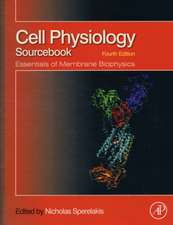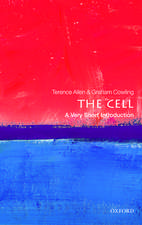Mechanisms and Consequences of Proton Transport
Editat de Tetsuro Urushidani, John G. Forte, George Sachsen Limba Engleză Hardback – 30 iul 2002
| Toate formatele și edițiile | Preț | Express |
|---|---|---|
| Paperback (1) | 948.79 lei 6-8 săpt. | |
| Springer Us – 28 oct 2012 | 948.79 lei 6-8 săpt. | |
| Hardback (1) | 954.93 lei 6-8 săpt. | |
| Springer Us – 30 iul 2002 | 954.93 lei 6-8 săpt. |
Preț: 954.93 lei
Preț vechi: 1164.56 lei
-18% Nou
Puncte Express: 1432
Preț estimativ în valută:
182.75€ • 198.44$ • 153.51£
182.75€ • 198.44$ • 153.51£
Carte tipărită la comandă
Livrare economică 23 aprilie-07 mai
Preluare comenzi: 021 569.72.76
Specificații
ISBN-13: 9781402070594
ISBN-10: 1402070594
Pagini: 388
Ilustrații: XIII, 372 p.
Dimensiuni: 155 x 235 x 29 mm
Greutate: 0.72 kg
Ediția:2002
Editura: Springer Us
Colecția Springer
Locul publicării:New York, NY, United States
ISBN-10: 1402070594
Pagini: 388
Ilustrații: XIII, 372 p.
Dimensiuni: 155 x 235 x 29 mm
Greutate: 0.72 kg
Ediția:2002
Editura: Springer Us
Colecția Springer
Locul publicării:New York, NY, United States
Public țintă
ResearchDescriere
This volume represents the proceedings of the 9th International Proton Transport Conference, "Mechanisms and Consequences of Proton Transport" held in Leura, Australia, August 19 -21, 200 I. This conference has been held since 1971 every 3 to 4 years with few exceptions in association with the Congress of the International Union of Physiological Sciences. The first meeting was held in Frankfurt, Germany, at the Max-Planck'Institute. Countries hosting the conference have been Germany (twice), Sweden (twice), India, Canada, USA, Great Britain, and now Australia. Over the past 30 years participants at these Proton Transport Conferences have been principal contributors to the major discoveries in the physiology, biochemistry and pharmacology of gastric acid secretion. These include development of the H2-receptor blockers, defining the signaling pathways for the regulation of acid secretion, identifying the gastric proton pump, discovery and development of proton pump inhibitory drugs, and elucidating the physiology and biochemistry of Helicobacter pylori.
Cuprins
Preface. Structure and Function of H,K-ATPASE - Molecular Basis for Drug Targets. 1. The Gastric H,K-ATPase; O. Vagin, et al. 2. Human Nongastric H,K-ATPase: Current View On Structure and Functional Properties; G. Adams, et al. 3. Functional Consequences of Subunit Interactions in Na,K- and H,K-ATPases; G. Crambert, et al. 4. HKcalpha Encodes Ouabain-Insensitive H,K-ATPase in Surface Cells of Rat Distal Colon; H.J. Binder. 5. Molecular Diversity and Regulatory Heterogeneity of H,K-ATPases in Kidney; T.D. Dubose, et al. 6. Mutational Analysis of Gastric Proton Pump, alpha- and beta-Subunits; S. Asano, et al. 7. Structure-Activity Relationships of Na,K-ATPase, and H,K-ATPase; J.J.H.H.M. de Pont, et al. 8. The Effect of Mutations Within a Cluster of Homologous Amino Acids Present in the M5, M6 and M8 Transmembrane Regions of the H,K-ATPase; E.C. Rabon, et al. 9. Host-Specific H. pylori Inhibition of H,K-ATPase alpha Subunit Gene Expression; A. Smolka, M. Göõz. 10. H+,K+-ATPase, the Dominant Gastric Autoantigen In Helicobacter pylori Infection; B.J. Appelmelk, et al. 11. The Gastric H/K ATPase in the Pathogenesis of Autoimmune Gastritis; B.-H. Toh, et al. 12. Duodenal Protection: Influence of Melatonin and Other Intestinal Transmitters on Duodenal Bicarbonate Secretion and Enterocyte Signaling; G. Flemström, M. Sjöblom. 13. Role of Cytokines in Helicobacter pylori-Induced Gastric Epithelial Cell Matrix Metalloproteinase Secretion and Activation; M. Gööz, et al. 14. HCl Causes LessIntracellular Acidification in Surface Epithelial Cells of Necturus Gastric Mucosa than Other Inorganic Acids; T. Kiviluoto, et al. 15. Ethanol Increases Intracellular Free Calcium, Closes Gap Junctions and Decreased Cell Volume in Primary Cultured Rabbit Gastric Epithelial Cell Monolayers; E. Kivilaakso, et al. 16. Induction of Small Intestinal Damage by Inhibition of Both NO Synthase and COX-2; A. Tanaka, et al. 17. Role of Protein Kinases on Acid-Induced Duodenal Bicarbonate Secretion in Rats; O. Furukawa, et al. 18. Acid Induces Duodenal Epithelial Acidification and HCO3-Secretion via Activation of the Na+:HCO3-Cotransporter and CFTR in Mice; M. Hirokawa, et al. Gene Targeting Mouse &endash; Mechanisms of Acid Secretion and Cell Proliferation. 19. Insights into the Cell Biology, Development and Pathology of the Gastric Mucosa Revealed in Gastric H/K ATPase and Gastrin-Deficient Mice; I. van Driel, et al. 20. Genetically Engineered Animal Model: Physiological Studies with Gastrin in Transgenic Mice; G.J. Dockray, et al. 21. Gastric Cytoprotection by Prostaglandin E2 &endash; Relation to EP Receptor Subtypes; K. Takeuchi, et al. 22. Gastric Mucus Accumulation is Reduced in Helicobacter pylori Infected Transgenic Mice Expressing the Human α1,3/4-Fucosyltransferase in Surface Epithelial Cells; J. Henriksnäs, et al. Signal Transduction in the Parietal Cell &endash; Pathway to Activation. 23. New Insights into Second Regulation of Parietal Cell Function by Novel Downstream Signaling Proteins; C.S. Chew, et al. 24.
Notă biografică
Tetsuro Urushidani is an associate professor in the Laboratory of Pharmacology and Toxicology, Graduate School of Pharmaceutical Sciences, The University of Tokyo.John G. Forte is a professor in the Department of Molecular and Cell Biology, University of California at Berkeley.George Sachs is Director of the Membrane Biology Laboratory, University of California, Los Angeles, Professor of Physiology and Medicine, UCLA, Wilshire Chair in Medicine, UCLA, and Co-Director of the Center for Ulcer Research and Education, UCLA.









